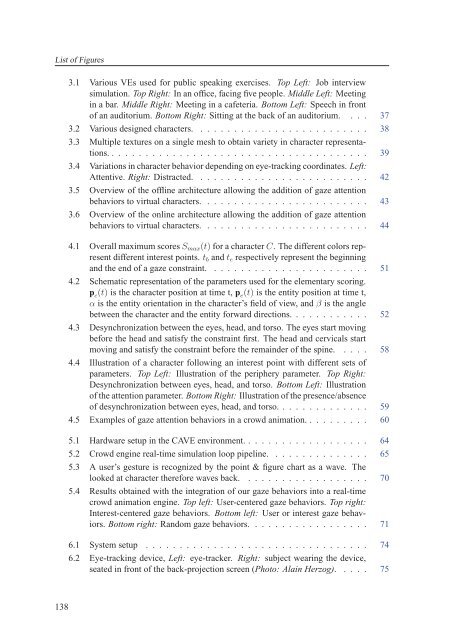Texte intégral / Full text (pdf, 20 MiB) - Infoscience - EPFL
Texte intégral / Full text (pdf, 20 MiB) - Infoscience - EPFL
Texte intégral / Full text (pdf, 20 MiB) - Infoscience - EPFL
Create successful ePaper yourself
Turn your PDF publications into a flip-book with our unique Google optimized e-Paper software.
List of Figures<br />
138<br />
3.1 Various VEs used for public speaking exercises. Top Left: Job interview<br />
simulation. Top Right: In an office, facing five people. Middle Left: Meeting<br />
in a bar. Middle Right: Meeting in a cafeteria. Bottom Left: Speech in front<br />
of an auditorium. Bottom Right: Sitting at the back of an auditorium. . . . 37<br />
3.2 Various designed characters. . . . . . . . . . . . . . . . . . . . . . . . . . 38<br />
3.3 Multiple <strong>text</strong>ures on a single mesh to obtain variety in character representations.<br />
. . . . . . . . . . . . . . . . . . . . . . . . . . . . . . . . . . . . . . 39<br />
3.4 Variations in character behavior depending on eye-tracking coordinates. Left:<br />
Attentive. Right: Distracted. . . . . . . . . . . . . . . . . . . . . . . . . . 42<br />
3.5 Overview of the offline architecture allowing the addition of gaze attention<br />
behaviors to virtual characters. . . . . . . . . . . . . . . . . . . . . . . . . 43<br />
3.6 Overview of the online architecture allowing the addition of gaze attention<br />
behaviors to virtual characters. . . . . . . . . . . . . . . . . . . . . . . . . 44<br />
4.1 Overall maximum scores Smax(t) for a character C. The different colors represent<br />
different interest points. tb and te respectively represent the beginning<br />
and the end of a gaze constraint. . . . . . . . . . . . . . . . . . . . . . . . 51<br />
4.2 Schematic representation of the parameters used for the elementary scoring.<br />
pc(t) is the character position at time t, pe(t) is the entity position at time t,<br />
α is the entity orientation in the character’s field of view, and β is the angle<br />
between the character and the entity forward directions. . . . . . . . . . . . 52<br />
4.3 Desynchronization between the eyes, head, and torso. The eyes start moving<br />
before the head and satisfy the constraint first. The head and cervicals start<br />
moving and satisfy the constraint before the remainder of the spine. . . . . 58<br />
4.4 Illustration of a character following an interest point with different sets of<br />
parameters. Top Left: Illustration of the periphery parameter. Top Right:<br />
Desynchronization between eyes, head, and torso. Bottom Left: Illustration<br />
of the attention parameter. Bottom Right: Illustration of the presence/absence<br />
of desynchronization between eyes, head, and torso. . . . . . . . . . . . . . 59<br />
4.5 Examples of gaze attention behaviors in a crowd animation. . . . . . . . . . 60<br />
5.1 Hardware setup in the CAVE environment. . . . . . . . . . . . . . . . . . . 64<br />
5.2 Crowd engine real-time simulation loop pipeline. . . . . . . . . . . . . . . 65<br />
5.3 A user’s gesture is recognized by the point & figure chart as a wave. The<br />
looked at character therefore waves back. . . . . . . . . . . . . . . . . . . 70<br />
5.4 Results obtained with the integration of our gaze behaviors into a real-time<br />
crowd animation engine. Top left: User-centered gaze behaviors. Top right:<br />
Interest-centered gaze behaviors. Bottom left: User or interest gaze behaviors.<br />
Bottom right: Random gaze behaviors. . . . . . . . . . . . . . . . . . 71<br />
6.1 System setup . . . . . . . . . . . . . . . . . . . . . . . . . . . . . . . . . 74<br />
6.2 Eye-tracking device, Left: eye-tracker. Right: subject wearing the device,<br />
seated in front of the back-projection screen (Photo: Alain Herzog). . . . . 75

















